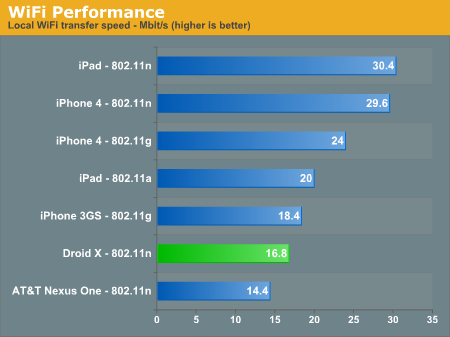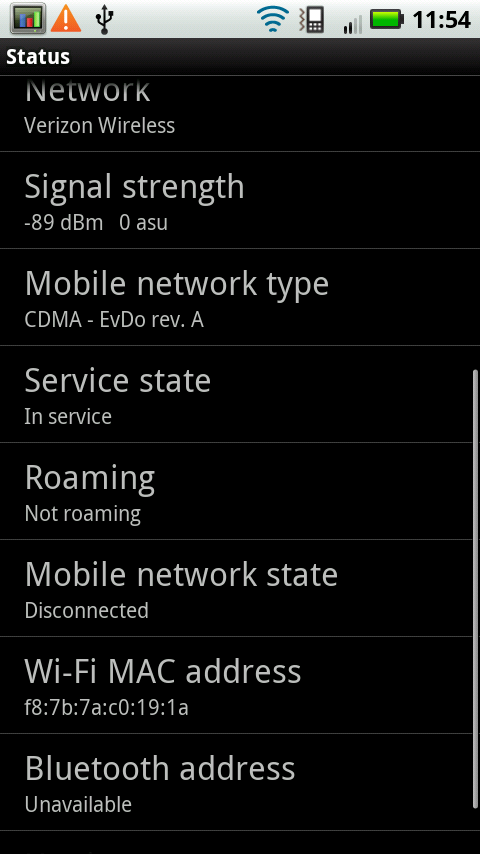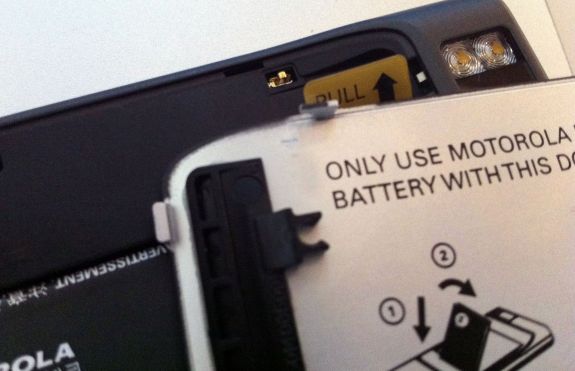Motorola Droid X: Thoroughly Reviewed
by Brian Klug on July 20, 2010 4:27 PM EST- Posted in
- Smartphones
- Motorola Droid X
- OMAP
- Mobile
Connectivity
The X supports CDMA 800/1900 and Ev-DO Revision A for data. There’s also Bluetooth 2.1+EDR, and WiFi 802.11g/n. I did notice N working at 72 megabits/s which seems to be the standard negotiated N connection speed for smartphones lately.
I’m somewhat of a speedtest freak, and I’ve run just shy of 100 speedtests on the X over cellular data. My average downstream speed has come to 0.91 megabits/s, upload is 0.73 megabits/s. This is completely on par with what I’d expect from CDMA 200 Ev-DO Rev.A networks. Though it isn’t anything special, I give the X credit for performing up to par, especially considering the number of... erm... devices that are shipping with some variety of radio problem.
Unfortunately, I did experience a lot of disconnections when connecting to N wireless networks. Searching online, a lot of people seem to be experiencing the same issue. Initially this posed a big problem for our WiFi page loading battery life benchmark, as I had to keep checking every 10 minutes to see if the phone was still connected. Later, I tried connecting to my WRT54G-TM running tomato (802.11g) and completed the test with a solid connection.
Later, I ran my WiFi throughput tests and noticed that the connection would drop on 802.11n whenever throughput started to go very fast, as it approached real N rates on my network. I switched back and forth between a WRT600N and latest generation Airport Extreme - both elicited the same behavior. The connection would drop, and sometimes not resume until I manually turned WiFi off and back on. This is very similar to some of the connectivity issues I’ve experienced with immature 802.11n stacks on the desktop, or due to chipset incompatibilities. Connecting to 802.11g, I was able to hold a solid connection without trouble.
Clearly the problem seems to be with the WiFi stack when connected to 802.11n networks. Hopefully this will be corrected in the future with some software update. There were rumors that this would be fixed with the July 19th update to 1.13.604 - it seems that review units were pushed this update a week early, as I saw it a while ago. WiFi still drops and reconnects periodically even running this version of the software and baseband.
Throughput on the X while downloading a 100 MB PDF stored locally was 16.8 megabits/s.

I also noticed that the X has longer wireless range than the EVO. I’ve been asked in the past to test wireless range - the X, Nexus One, and iPhone 4 I had on hand all kept stable WiFi connections to roughly the same distance.
Cellular Antennas
There’s also been a bit of discussion lately about the X’s diversity antenna configuration. If nothing else, the iPhone 4 antenna controversy has drawn attention to the fact that attenuation due to the composition of your hand happens on all devices.

Getting signal strength in dBm on Android is as easy as about -> status. Or a documented dialer code.
So how does the X fare? I saw a worst case drop of 15 dB on the X, cupping it tightly death grip style. I had an original Droid side by side and saw the same signal (-89 dBm at my house), so reception without holding the phone is unscientifically the same. The X drops signal about the same amount of signal due to attenuation from your hand being in the way as every other smartphone with an internal antenna. 15 dB is completely typical.
| Signal Attenuation Comparison in dB - Lower is Better | |||||||
| Cupping Tightly | Holding Naturally | On an Open Palm | Holding Naturally Inside Case | ||||
| Droid X | 15.0 | 5.1 | 4.5 | NA | |||
| iPhone 4 | 24.6 | 19.8 | 9.2 | 7.2 | |||
| iPhone 3GS | 14.3 | 1.9 | 0.2 | 3.2 | |||
| HTC Nexus One | 17.7 | 10.7 | 6.7 | 7.7 | |||
I’m not entirely sure what’s going on with the X’s spatially diverse antennas - I could make signal drop when holding the bottom of the phone, which is standard placement area for smartphone antennas these days, yet no drop happened when I cupped the top half tightly. I’m not saying definitively that there isn’t spatial diversity for the cellular antenna, just that I could never see evidence of it in the numbers. Perhaps Motorola is doing something much more subtle, or the value being reported in Field Trial is only for the bottom antenna - it’s entirely possible that the reporting I saw in the Field Trial and About -> Status doesn't reflect what the baseband is seeing.
I noticed something else curious and briefly made mention of it before. On the back of the phone under the battery door, there’s a gold contact that makes contact with the battery door. There are also three metal connectors that make contact with the tabs that lock the door in place.
Is the X pulling an iPhone 4 with creative antenna design? It seems possible, though I’m not sure what it’s being used for. WiFi signal strength is the same with the battery door on and off, as is cellular, and GPS. It also isn’t being used to tell if the door is on or not, as the device works the same with it on or off. Perhaps this is just for grounding.











89 Comments
View All Comments
czesiu - Tuesday, July 20, 2010 - link
great review!higher res version for this please:)
http://images.anandtech.com/doci/3826/DROIDX-Anand...
Brian Klug - Tuesday, July 20, 2010 - link
I'm actually going to dump all the screen comparison photos I've got (there are quite a few) into a gallery, then you can peruse at native resolution. Should be up in a little bit ;)-Brian
hatter_india - Tuesday, July 20, 2010 - link
Fantastic review but I expect no less from AnandTech. But there are a couple of bloopers:1- OMAP 3630 is third mobile chip to use 45nm process. First is of course A4. But second is Samsung's Hummingbird, a chip that the korean company designed with help of Intrinsity. This chip is found in Galaxy S or its variants. Samsung is the same company that also tweaked A4, which incidentally is fabbed by Samsung. Too many coincidences ;-)
2- A comparison to PowerVR SGX 540 found on Galaxy S would have been interesting as according to Samsung SGX 540 is almost three times more powerful than SGX535.
3- Droid X should have also been compared with Galaxy S or any of its variants like Captivate, Vibrant etc
hatter_india - Tuesday, July 20, 2010 - link
This line: Samsung is the same company that also tweaked A4, which incidentally is fabbed by SamsungShould read: Intrinsity is the same company that also tweaked A4, which incidentally is fabbed by Samsung
Goty - Tuesday, July 20, 2010 - link
Does AT have any plans to review any of the Galaxy S phones? I just picked up a Captivate on Sunday and I'd love to see how it stacks up. I just ran the Neocore benchmark and got around 55 FPS, which speaks well of the GPU, but I'd like to see results from the other tests you guys do.Brian Klug - Tuesday, July 20, 2010 - link
Hey Goty,We definitely have plans to do reviews of all of the Galaxy S phones we can get our hands on. I'm working on getting them as soon as possible ;)
I'm also pretty excited to explore that SoC and compare.
-Brian
Ram21 - Tuesday, July 20, 2010 - link
Really enjoyed this review. Keep up the great work! Being as thorough as you guys are really helps to make good decisions on purchases.SonicIce - Tuesday, July 20, 2010 - link
lol how long before we can attach an external mouse and keyboard to a phone to use it as a pc and play 3d games online with itstrikeback03 - Tuesday, July 27, 2010 - link
How about this?http://www.androidcentral.com/dell-streak-logitech...
ltfields - Tuesday, July 20, 2010 - link
Guys, another gold standard review. I may not be able to pick up an X because I'm still under contract with another carrier, but the reviews are riveting. Keep up the excellent work!